- Global markets under pressure ahead of first US election debate
- Impact of presidential debate on market unclear
- Worldwide pandemic deaths reach 1 million
Key Events
European stocks and US futures were down on Tuesday following a mixed Asian session. Futures on the four major US indices—the Dow S&P 500, NASDAQ and Russell 2000—have fallen for the last three hours after the underlying benchmarks advanced on Monday, the biggest jump in over two weeks.
Investors are scaling back positions ahead of the first US presidential debate, as well as on concerns that the ongoing US Congressional fiscal stimulus talks are not yet close to a deal, plus the news that global deaths from COVID-19 have reached 1 million fatalities.
Global Financial Affairs
Almost 100 million people are expected to tune in to the US presidential debate after markets close on Tuesday. Investors are eager to learn both candidates' plans for the US economy which has been battered by lockdowns during the pandemic.
Many investors believe that a win for Biden on Nov. 3 could increase the chance of fiscal stimulus for the economy, which would be a positive for the stock market. However, others are in favor of a Trump win as stock markets typically prefer a Republican in the White House.
Nonetheless, markets are under pressure after yesterday's rally. Contracts on the NASDAQ 100 remain well off their lows.
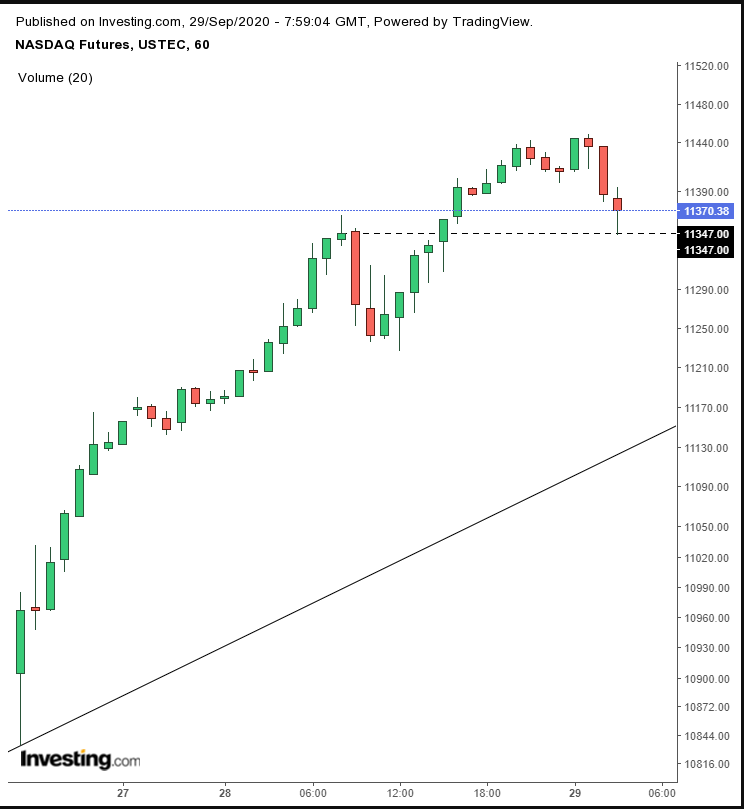
The NQ is finding support above Monday’s highs.
This morning, the Stoxx Europe 600 Index opened lower, as traders took profits after from Monday’s 2.2% surge, the biggest in 15 weeks.
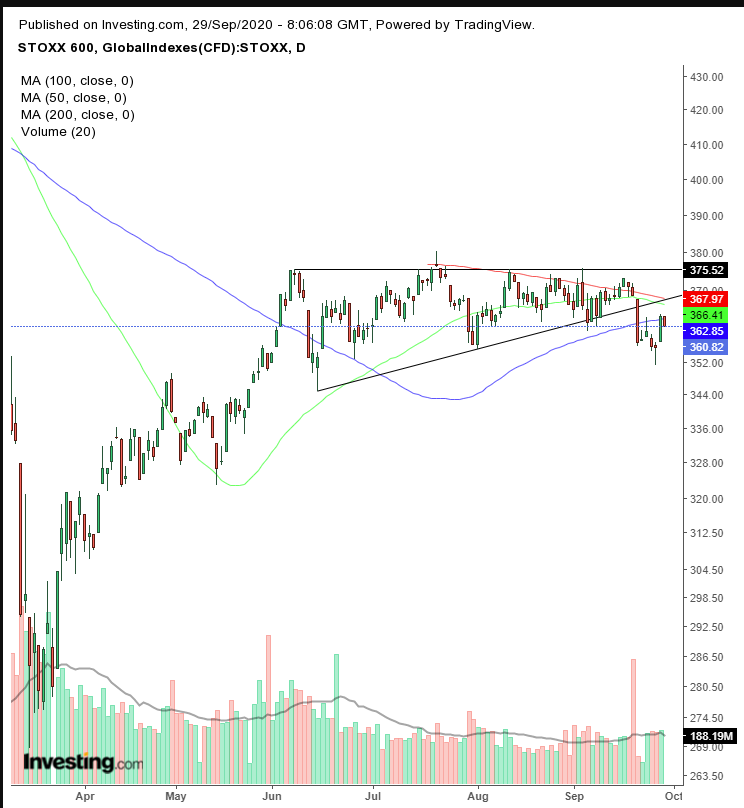
Growth sectors banks, automakers, and travel and leisure underperformed following the news that the coronavirus pandemic has taken the lives of 1 million people worldwide.
The selloff comes at what may be the end of a return-move following the downside breakout of a descending triangle, with the 50 DMA falling away from the a falling 200 DMA. The price fell below the 100 DMA, having tested it for the second time in five sessions, after falling below it for the first time since the bearish pattern developed.
Earlier Tuesday, Asian stocks were mostly in a holding pattern, awaiting the US presidential debate. The event seems to be garnering even more focus from investors now that COVID-19 deaths have topped the psychological one million mark.
Among the major Asian benchmarks, China outperformed, helped by technology stocks which were boosted after data published Sunday demonstrated the country’s industrial firms expanded for the fourth straight month in August. The World Bank is now projecting growth of at least 2% in the world’s second largest economy.
This morning's slump follows Monday's global rally. US equities jumped after four weeks of decline, which included a new low last week when Wall Street indices fell to their lowest since July. Over 90% of stocks rose, as talks on the new fiscal stimulus progressed in Congress and comments from Nancy Pelosi, the US House of Representatives Speaker, indicated that she thinks a deal can be reached on a new coronavirus relief package. The stronger economic data from China also helped to lift investors' mood.
Yields fell to their lowest level since Sept. 3. Election jitters are also flattening the yield curve at the long end of the Treasury spectrum.
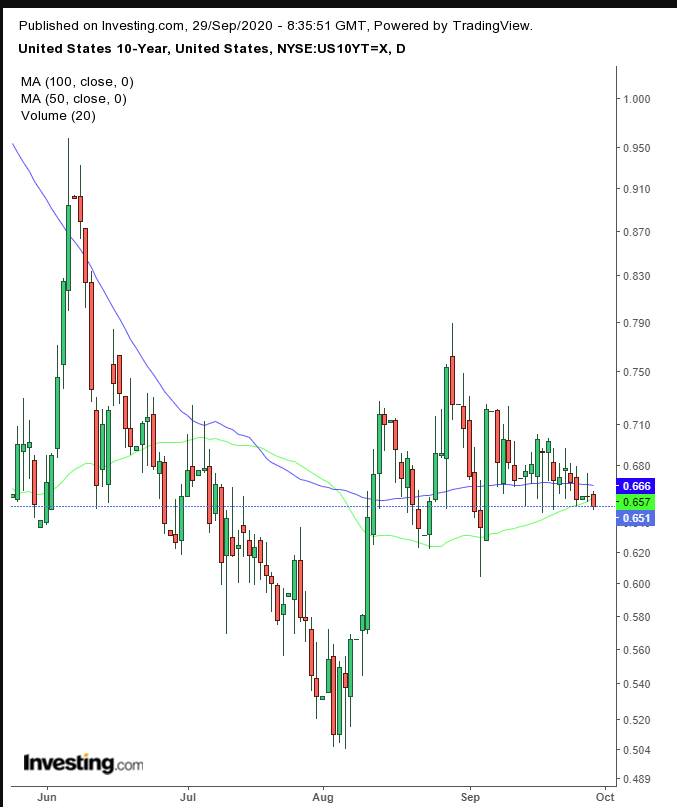
The 10-year Treasury note fell below the 50 DMA for the first time since June 24, after already clearing the 100 DMA, signaling rates are topping out.
Meanwhile, the dollar continues to keep traders guessing.

The greenback is hovering unchanged after Monday's decline from the top of a short-term rising channel, after nearing the top of the long-term falling channel on Friday. The question is whether a pullback will simply be part of a return-move to a bottom, or will the dollar continue along its long-term downtrend.
Gold jumped higher on dollar weakness after finding clear support by the 100 DMA for multiple sessions.
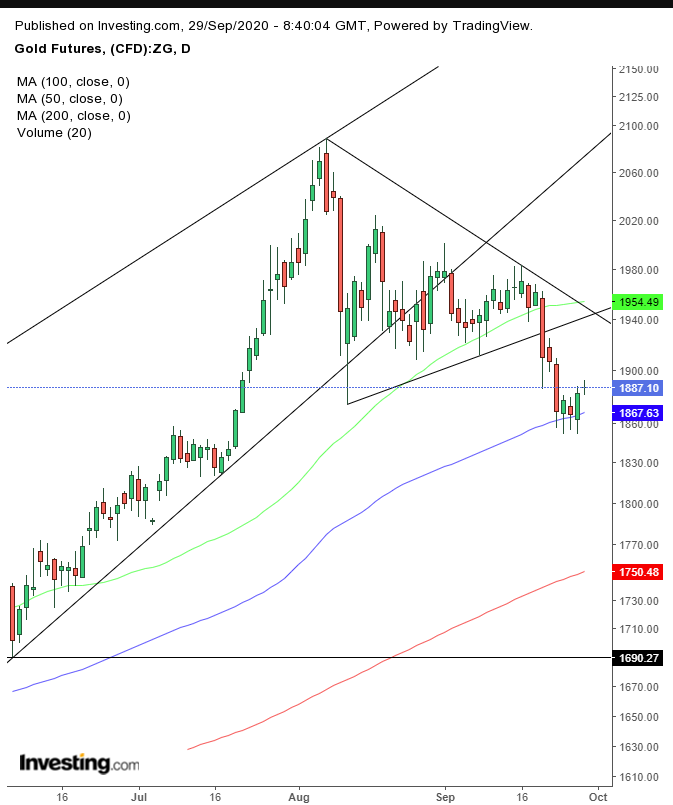
Will that be enough to throw the price of the yellow metal back into an uptrend, after providing a downside breakout to a range, that pushed the commodity out of its rising channel? At least from a technical standpoint, the short-term bias is to the downside.
Oil is falling, paring half of Monday's gains, ahead of Wednesday's inventory report.
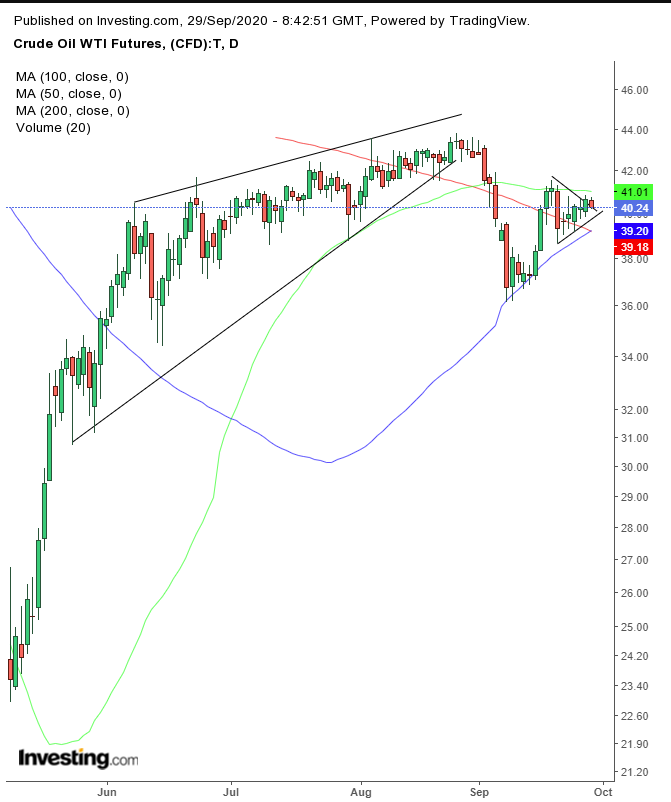
Technically, oil is testing the top of a pennant, whose upside breakout would prove bullish. This expectation of a move higher demonstrates how unclear the market's trajectory is, even after it completed a bearish rising wedge less than a month ago. Ironically, the bearish pattern’s completion coincided with a golden cross, more mixed signals.
Up Ahead
- The first US presidential debate between President Donald Trump and Vice President Joe Biden takes place later today at 9PM eastern (1AM Wednesday GMT)
- On Wednesday, China reports its purchasing manager indexes. The releases are expected to show September manufacturing improved slightly while non-manufacturing moderated from August’s level.
- The EIA's crude oil inventory report is released Wednesday.
- The September US employment report on Friday will be the last before the November election.
Market Moves
Stocks
- The Stoxx Europe 600 Index declined 0.5%.
- Futures on the S&P 500 Index decreased 0.3%.
- NASDAQ 100 Index futures dipped 0.4%.
- The MSCI Asia Pacific Index fell 0.1%.
Currencies
- The Dollar Index advanced 0.1% to 94.28
- Sterling was little changed at 0.909 per euro.
- The Japanese yen weakened 0.2% to 105.69 per dollar.
- South Africa’s rand weakened 0.6% to 17.1646 per dollar.
Bonds
- The yield on 10-year Treasuries fell less than one basis point to 0.65%.
- Germany’s 10-year yield declined one basis point to -0.54%.
- Britain’s 10-year yield decreased one basis point to 0.195%.
- Italy’s 10-year yield dipped one basis point to 0.871%.
